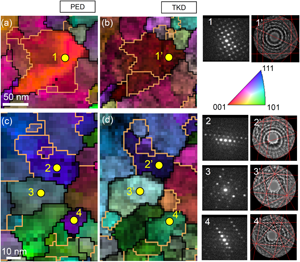Article contents
Crystallographic Orientation Analysis of Nanocrystalline Tungsten Thin Film Using TEM Precession Electron Diffraction and SEM Transmission Kikuchi Diffraction
Published online by Cambridge University Press: 05 February 2021
Abstract

Two advanced, automated crystal orientation mapping techniques suited for nanocrystalline materials—precession electron diffraction (PED) in transmission electron microscopy (TEM) and on-axis transmission Kikuchi diffraction (TKD) in scanning electron microscopy (SEM)—are evaluated by comparing the orientation maps obtained from the identical location on a 30 nm-thick nanocrystalline tungsten (W) thin film. A side-by-side comparison of the orientation maps directly showed that the large-scale orientation features are almost identical. However, there are differences in the fine details, which arise from the fundamentally different nature of the spot pattern and Kikuchi line pattern in terms of the excitation volume and the angular resolution. While TEM-PED is more reliable to characterize grains oriented along low-index zone axes, the high angular resolution of SEM-TKD allows the detection of small misorientation between grains and thus yields better quantification and statistical analysis of grain orientation. Given that both TEM-PED and SEM-TKD orientation mapping techniques are complementary tools for nanocrystalline materials, one can be favorably selected depending on the requirements of the analysis, as they have competitive performance in terms of angular resolution and texture quantification.
Keywords
- Type
- Materials Science Applications
- Information
- Copyright
- Copyright © The Author(s), 2021. Published by Cambridge University Press on behalf of the Microscopy Society of America
Footnotes
These authors contributed equally to this work.
References
- 9
- Cited by



